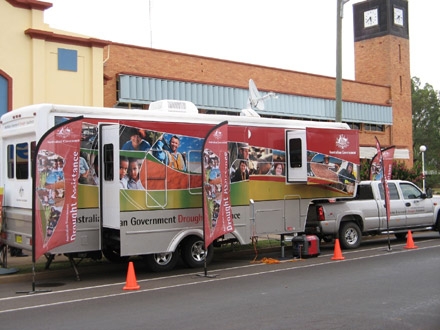Centrelink cuts the wires on disaster buses

Originally designed to service drought affected areas, Centrelink's Drought Buses are being used for all emergency conditions. ZDNet.com.au talks with Centrelink's acting national manager for IT service delivery, Mat Rogers, about how tech keeps the agency on the road.
Using Centrelink, the federal government is attempting to extend its services to citizens and business owners in rural regions affected not just by drought but also floods and other initiatives such as the controversial Northern Territory intervention.

If you're experiencing floods, don't be surprised by the Drought Bus.
(Credit: Centrelink)
Three buses currently roam the breadth of the nation. Thanks to recent storms in Queensland and the forced closure of Centrelink's offices in Charleville, Queensland, the buses have also been used to extend emergency financial relief to flood victims there.
Centrelink's IT equipment was damaged by the floods, and unable to operate, prompting the agency to reroute the buses to deliver emergency services there, according to Rogers.
To enable staff access to Centrelink's mainframe, each of the buses has been equipped with both satellite and Next G connectivity.
According to Rogers, the NewSat satellite system acts as a backup for black spots in regional areas where Telstra's Next G network fails to cover.
"Staff use laptops and there are self-service PCs for customers to access online services. Staff can sit outside with the customers, using the system in real time over Next G to access our mainframe and backend systems," said Rogers.
"We've also built some smarts into it. The last thing a customer service operator wants to do is find 3G coverage [on the road]. So we have built auto-sensing into the bus to detect 3G signals and if there are none, it will automatically move over to satellite."
(Credit: Centrelink)
Although, according to Rogers, the complexity of providing remote access services "isn't that much of a problem", security is a major priority.
"It's a matter of securing and authenticating the processing claims. We use a fully encrypted link to DSD [Defence Signals Directorate] specifications," he said.
With the agency facing criticism over staff breaching privacy regulations last year, Rodgers said authentication of access by staff to Centrelink's mainframe is critical. It will soon by trialling a new authentication system for its 27,000 staff.
As far as technical problems with laptops, Centrelink's support is provided by HP, the vendor which supplies the laptop and desktops for the agency.
"The buses also come in on a quarterly basis so that the providers of the buses can service them. At the time, all our IT comes in for an equipment check," he said.